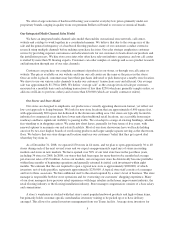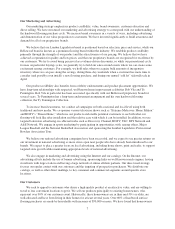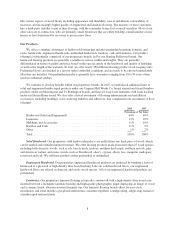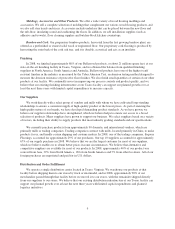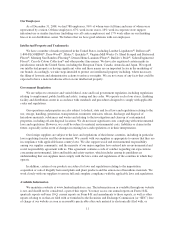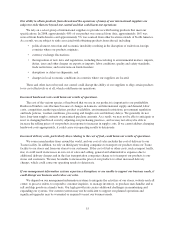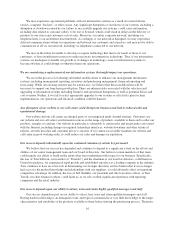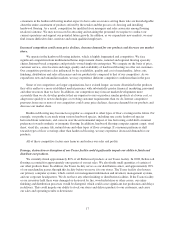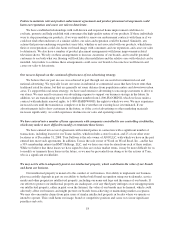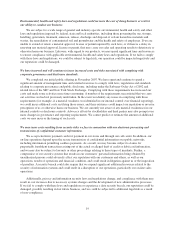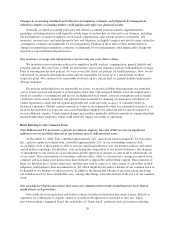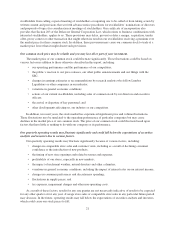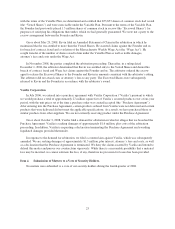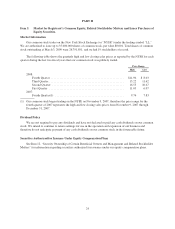Lumber Liquidators 2008 Annual Report Download - page 21
Download and view the complete annual report
Please find page 21 of the 2008 Lumber Liquidators annual report below. You can navigate through the pages in the report by either clicking on the pages listed below, or by using the keyword search tool below to find specific information within the annual report.Our ability to obtain products from abroad and the operations of many of our international suppliers are
subject to risks that are beyond our control and that could harm our operations.
We rely on a select group of international suppliers to provide us with flooring products that meet our
specifications. In 2008, approximately 40% of our product was sourced from Asia, approximately 16% was
sourced from South America and approximately 5% was sourced from other locations outside of North America.
As a result, we are subject to risks associated with obtaining products from abroad, including:
• political unrest, terrorism and economic instability resulting in the disruption of trade from foreign
countries where our products originate;
• currency exchange fluctuations;
• the imposition of new laws and regulations, including those relating to environmental matters; imports,
duties, taxes and other charges on exports or imports; labor conditions; quality and safety standards;
trade restrictions; and restrictions on funds transfers;
• disruptions or delays in shipments; and
• changes in local economic conditions in countries where our suppliers are located.
These and other factors beyond our control could disrupt the ability of our suppliers to ship certain products
to us cost-effectively or at all, which could harm our operations.
Increased hardwood costs could harm our results of operations.
The cost of the various species of hardwood that we use in our products is important to our profitability.
Hardwood lumber costs fluctuate because of changes in domestic and international supply and demand, labor
costs, competition, market speculation, product availability, environmental restrictions, government regulation
and trade policies, weather conditions, processing and freight costs and delivery delays. We generally do not
have long-term supply contracts or guaranteed purchase amounts. As a result, we may not be able to anticipate or
react to changing hardwood costs by adjusting our purchasing practices, and we may not always be able to
increase the selling prices of our products in response to increases in supply costs. If we cannot address changing
hardwood costs appropriately, it could cause our operating results to deteriorate.
Increased delivery costs, particularly those relating to the cost of fuel, could harm our results of operations.
We source merchandise from around the world, and our cost of sales includes the cost of delivery to our
Toano facility. In addition, we rely on third-party trucking companies to transport our products from our Toano
facility to our stores and from our stores to our customers. If the cost of fuel or other costs, such as import tariffs,
rise, it could result in increases in our cost of sales and selling, general and administrative expenses due to
additional delivery charges and in the fees transportation companies charge us to transport our products to our
stores and customers. We may be unable to increase the price of our products to offset increased delivery
charges, which could cause our operating results to deteriorate.
If our management information systems experience disruptions or are unable to support our business needs, it
could disrupt our business and reduce our sales.
We depend on our management information systems to integrate the activities of our stores, website and call
center, to process orders, to respond to customer inquiries, to manage inventory, to purchase merchandise and to
sell and ship goods on a timely basis. Our high growth rate creates additional challenges in maintaining and
expanding our systems. Our current systems may not be sufficient to support our planned operations and
significant upgrades may be warranted or required to meet our business needs.
15


